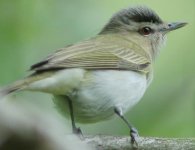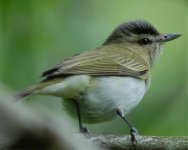Terry O'Nolley
Cow-headed Jaybird
First, my setup. I use a Nikon D-50 with a Nikkor AFED 300 film lens (effective 450mm).
Even when my pictures are in focus (via autofocus), they are not as sharp as many of the images that are posted here. There is always a soft outline to the subject.
I do not shoot in RAW mode, I use the highest resolution JPG setting.
Should I change to RAW mode?
I also have never post-processed my images. Is that something that should be done? How would film photographers have handled that without all the fancy digital tricks that can change what it was that you actually photographed?
Other possibilities:
I have heard of Noise Ninja. Is that considered "fair play" when sharing your images? It just seems to me that your final image should be what you shot - not what software does to fake your images.
I just want to get those crisp, sharp images I see here on a daily basis. If a person shooting with a non SLR little pocket camera through a digiscoping kit can get totally razor-sharp images, then why can't I when I am only shooting birds less than 30 feet away?
This is really frustrating and I am ready to trash my entire camera kit and start over.
(Please check out my gallery -you will see what I mean. The pics I upload are the ones I think are my best - but when I compare with others, they lack that sharpness)
Even when my pictures are in focus (via autofocus), they are not as sharp as many of the images that are posted here. There is always a soft outline to the subject.
I do not shoot in RAW mode, I use the highest resolution JPG setting.
Should I change to RAW mode?
I also have never post-processed my images. Is that something that should be done? How would film photographers have handled that without all the fancy digital tricks that can change what it was that you actually photographed?
Other possibilities:
- Not using a tripod
- Bad lens (not as sharp as it should be)
- Defective autofocus
I have heard of Noise Ninja. Is that considered "fair play" when sharing your images? It just seems to me that your final image should be what you shot - not what software does to fake your images.
I just want to get those crisp, sharp images I see here on a daily basis. If a person shooting with a non SLR little pocket camera through a digiscoping kit can get totally razor-sharp images, then why can't I when I am only shooting birds less than 30 feet away?
This is really frustrating and I am ready to trash my entire camera kit and start over.
(Please check out my gallery -you will see what I mean. The pics I upload are the ones I think are my best - but when I compare with others, they lack that sharpness)
Last edited:






